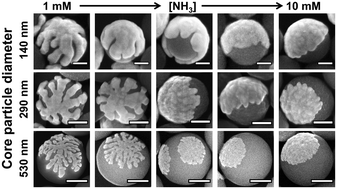On the complex role of ammonia in the electroless deposition of curved silver patches on silica nanospheres†
Abstract
The formation of thin silver patches on colloidal silica spheres using a Tollen's-like reaction with very low metal ion concentration and high excess of reducing agent is investigated. Through systematic variation of reaction parameters, electron microscopy and optical spectroscopy we elucidate why the crystalline coating grows conformal to the curved silica surface. The type and concentration of the base used in the reaction are identified as being critical parameters. Specifically, the base is shown to perform three functions. Besides complexing silver and raising the pH to drive the redox reaction it is proposed that interaction of the base with the silica core particle promotes conformal growth. In the case of ammonia it is inferred that this interaction is in the form of hydrogen bonds with the silica surface, which compromise ammonia's ability to coordinate silver. This in turn leads to a local modification of the silver moiety equilibrium towards more redox active non-complexed silver and hence a higher reduction rate at the patch edge and consequently, surface conformal growth. We demonstrate how this behaviour can be tuned by decreasing the ammonia concentration leading to a transition in the resulting silver patch morphology from one characteristic of reaction limited growth to one characteristic of diffusion limited growth. In situ measurements of the optical extinction of the growing silver patches qualitatively confirm this behaviour, with faster growth kinetics observed for lower ammonia concentration. For other amines, with lower propensity to form hydrogen bonds with silica or lacking the ability to complex silver, the coating quality is poorer or no coating is formed at all. The effect of core particle curvature on the coating morphology is also considered and it is demonstrated that even for 60 nm diameter silica spheres, a curved silver coating can be formed, albeit partially detached from the surface. Given this strong ability of silver to grow over the curved silica surface we do not observe morphological defects resulting from elastic instabilities seen in model studies with curved colloidal crystals. Nevertheless, our work opens up the exciting prospect of identifying the conditions for growing thin curved crystals of other metals provided that reagents with similar behaviour to ammonia in the present case can be identified.



 Please wait while we load your content...
Please wait while we load your content...